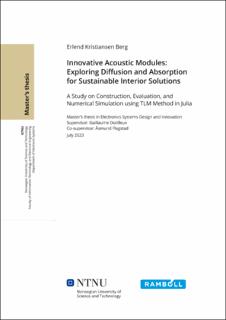Innovative Acoustic Modules: Exploring Diffusion and Absorption for Sustainable Interior Solutions
Master thesis
Permanent lenke
https://hdl.handle.net/11250/3099014Utgivelsesdato
2023Metadata
Vis full innførselSamlinger
Sammendrag
Denne masteroppgaven utforsker utviklingen og vurderingen av en innovativ akustiskmodul med både diffuse og absorberende egenskaper, med sikte på å tilby enmiljøvennlig og tilpasningsdyktig interiørløsning. Ved å kombinere teoretiske analyser,eksperimentelle undersøkelser og numeriske simuleringer ved hjelp av TransmissionLine Matrix (TLM) -metoden i Julia, har oppgaven som mål å evalueremodulens akustiske egenskaper og utforske mulige anvendelsesområder.De primære målene med denne forskningen er todelt: å undersøke modulensakustiske egenskaper i sine to unike tilstander (diffuse og absorberende) og å implementereen TLM-modell i Julia for å simulere målinger utført på de fysiskemodulene. Ved å utvikle en TLM-modell som kan forutsi modulens akustiske egenskaper,har studien som mål å forbedre designprosessen og optimalisere ytelsen tilmodulen.Gjennom grundige sammenligninger mellom eksperimentelle målinger og TLMsimuleringer,avdekker oppgaven utfordringer med å nøyaktig representere vissefrekvenser ved bruk av TLM-metoden. Likevel viser modulene seg å ha sværteffektive absorberende egenskaper, med gjennomsnittlige absorpsjonskoeffisienterover 0,7 i frekvensområdet 100-5000 Hz. Videre er de diffuse egenskapene ogsåsvært effektive, med gjennomsnittlige verdier over 0,6.I tillegg gjennomfører studien en rekke tester for å vurdere TLMs evne til ågjenskape akustiske egenskaper i tomme rom. Testene identifiserer mulige svakheterog foreslår metoder for å forbedre nøyaktigheten og påliteligheten til TLM-simuleringer.Denne masteroppgaven gir verdifulle innsikter i konstruksjon og vurderingav akustiske moduler, ved å kombinere avanserte simuleringsmetoder og eksperimenter.Resultatene belyser TLM-metodens utfordringer og styrker, og visermodulenes potensiale som allsidige og bærekraftige løsninger for interiørdesignmed akustiske funksjoner. Imidlertid krever TLM-metoden videre undersøkelserog utvikling for å nøyaktig simulere akustiske egenskaper til et test objekt medhøy presisjon. This master thesis delves into the development and evaluation of an innovativeacoustical module with both diffusive and absorptive properties, intended to offeran environmentally friendly and adaptable interior solution. Combining theoreticalanalyses, experimental investigations, and numerical simulations using theTransmission Line Matrix (TLM) method in Julia, the thesis aims to evaluate theacoustical characteristics of the module and explore its potential applications.The primary objectives of this research are twofold: to examine the module’sacoustical properties in its two unique states (diffusive and absorptive) and toimplement a TLM model within Julia to simulate the measurements performedon the physical modules. By creating a TLM model that can pre-determine theacoustical properties of the modules, the study seeks to enhance the design processand optimize the module’s performance.Through comprehensive comparisons between experimental measurements andTLM simulations, the thesis uncovers the TLM method’s challenges in accuratelyrepresenting certain frequencies. nevertheless, the modules demonstrate highlyeffective absorptive properties, with average absorption coefficient values between100-5000 Hz surpassing 0.7. Additionally, the diffusive properties are found to behighly effective averaging diffusion coefficient values above 0.6.Moreover, the study conducts a case study to evaluate the TLM’s ability tofaithfully portray acoustical behaviors within empty rooms. This case study identifiespotential weaknesses and proposes methods to mitigate them, enhancing theaccuracy and reliability of the TLM simulations.This master thesis contributes valuable insights into the construction and evaluationof acoustical modules in cooperation with Ramboll corporation, utilizingadvanced simulation methods and experimentation to analyze the module’s performance.The findings shed light on the challenges and strengths of the TLMmethod and demonstrate the modules’ effectiveness in both diffusion and absorption,making them promising candidates for versatile and sustainable interior designsolutions. However, the implemented TLM method serve not to be a viableoption for pre-determining the acoustical properties on the module and need tobe further examined and developed to properly simulate the acoustical propertieswith high accuracy.
